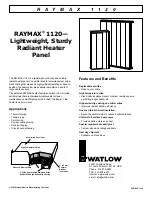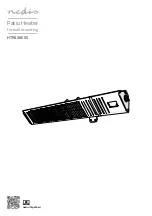
20
Dutchwest
30003847
Cleaning the Chimney System
The chimney system is composed of the chimney and
the pipe that connects the stove to the chimney. Inspect
the chimney and chimney connector at least twice
monthly, and clean if necessary.
When you first begin using the stove, check daily for
creosote — a substance that can look like either thick
tar or black, crisp flakes. Experience will show how
often you need to clean to be safe. The frequency
may even vary during the year. In the colder months
when the hottest fires producing the least creosote are
burned, you may need to clean only every couple of
months. During the warmer months when creosote is
more likely to result from cooler-burning fires, weekly
cleaning may be necessary.
At the very least, inspect the chimney connector and
chimney at least once every two months during the
heating season to determine if a buildup of creosote
or soot has occurred. If a significant layer of creosote
has accumulated (3 mm [1/8”] or more), or if soot has
accumulated, either should be removed to reduce the
risk of a chimney fire. Failure to keep the chimney and
connector system clean can result in a serious chimney
fire.
The conditions for a chimney fire develop as follows:
When wood is burned slowly, it produces tar and other
organic vapors which combine with expelled moisture
to form creosote. The creosote vapors condense in
the relatively cool chimney flue of a slow-burning fire.
As a result, creosote residue accumulates on the flue
lining. Creosote is flammable and, when ignited, makes
an extremely hot fire within the flue system which can
damage the chimney and overheat adjacent combus-
tible material.
To reduce the amount of creosote that may form, re-
member to provide adequate air for combustion and to
strive for small, intense fires rather than large, smolder-
ing ones.
You can never be too safe. Contact your local fire
authority for information on what to do in the event of
a chimney fire, and have a clearly understood plan on
how to handle one.
Inspect Regularly, Clean As Required
Inspect the chimney and chimney connector twice
monthly and clean if necessary. Let the stove cool
completely before you inspect the chimney. Use a flash-
light and mirror to sight up the flue through the chimney
clean-out door or chimney connector inspection tee. If
no inspection access is available, disconnect the pipe
from the stove.
Clean the chimney using a specially designed chimney
cleaning brush, the same size and shape as the flue
liner, attached to flexible fiberglass rods designed for
this purpose. Run the brush up and down the liner
so that any deposits fall to the bottom of the chimney
where they can be removed through the clean-out door.
Clean the chimney connector by disconnecting the sec-
tions, taking them outside, and removing any deposits
with a stiff wire brush. You can use a chimney brush of
correct size to clean chimney connector pipe. Reinstall
the connector sections after cleaning, being sure to
secure the individual sections with three sheet metal
screws per section.
If you are unable to inspect and/or clean the chimney
system yourself, contact your local Dutchwest dealer or
hire a qualified chimney sweep in your area to do the
job.
Maintenance Schedule
THE STOVE:
DAILY:
•
Ashes should be removed before they reach the top
of the ash pan. Check accumulation at least once a
day.
•
Keep the area around the stove clear of any com-
bustible materials such as wood, furniture or cloth-
ing.
TWO MONTHS:
•
Check door handle to be sure it is working properly.
Gasketing becomes compressed after a period of
time. Adjust handle tightness if necessary.
•
Check leg bolts and heat shield screws; tighten if
necessary.
Annual Spring Cleaning
•
Check gasketing for wear, and replace if necessary.
•
Remove ashes from the ash pan and replace with
a moisture absorbing material (such as kitty litter) to
keep the interior of the stove dry.
•
Inspect and clean the refractory package and cata-
lyst.
•
Clean the dust from the inner sides of bottom, rear or
pipe heat shields if your stove is equipped with them.
Clean surfaces are better heat reflectors than dirty
surfaces.
• Touch up the black paint.
Содержание 2460CE
Страница 28: ...28 Dutchwest 30003847...
Страница 29: ...29 Dutchwest 30003847...
Страница 30: ...30 Dutchwest 30003847...
Страница 32: ...MHSC 149 Cleveland Drive Paris Kentucky 40361 www mhsc com...













































